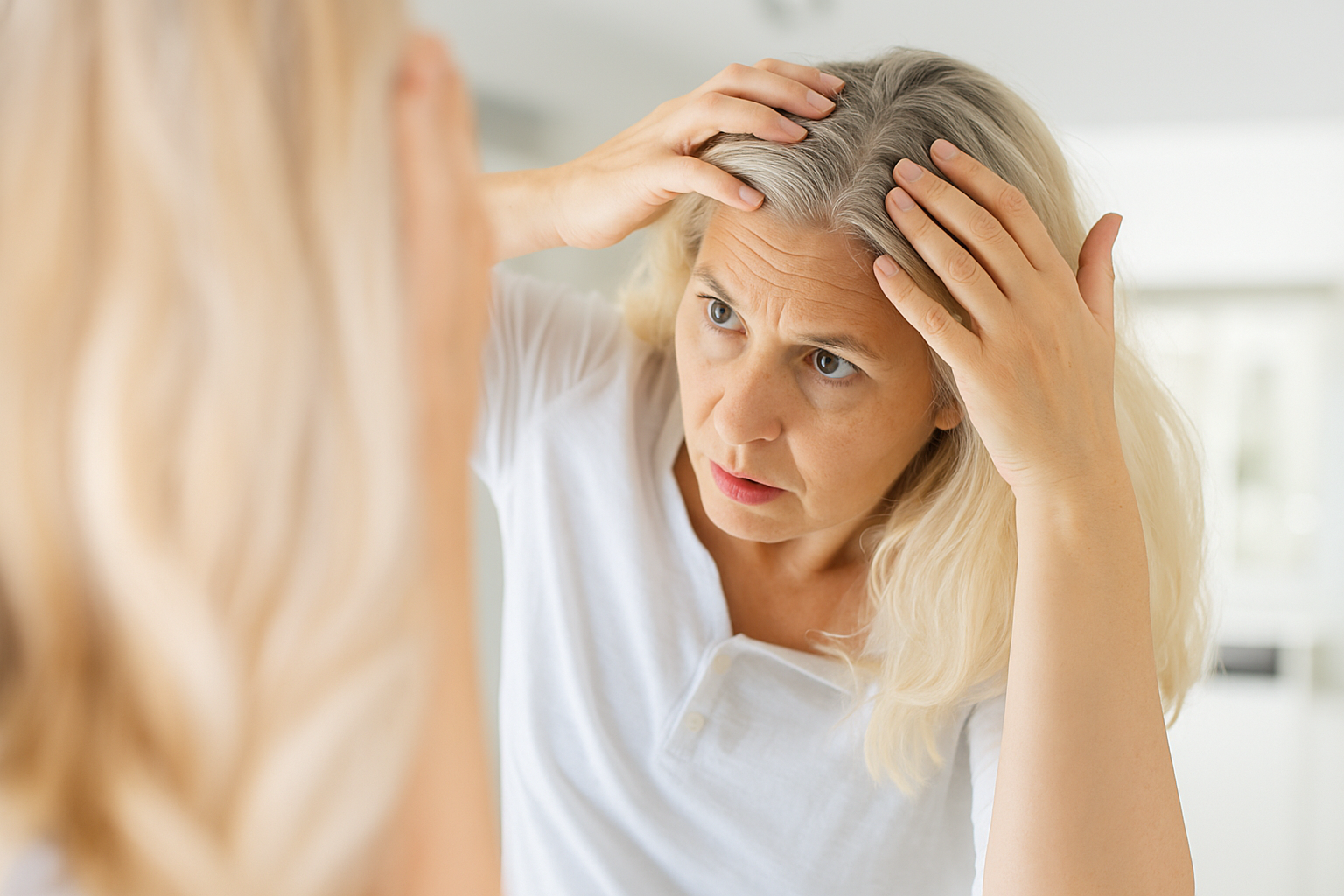Introduction
Hair graying is a natural process that most individuals experience as they age. However, when white or gray strands begin appearing in youth or early adulthood, the underlying causes often extend beyond aging. This article presents a detailed, fact-based overview of the primary causes of white hair, especially when it appears prematurely, and outlines scientifically grounded ways to manage and potentially prevent it using natural strategies. We explore genetics, biology, environmental triggers, and lifestyle habits in a realistic and practical way.
The Graying Spectrum: Youth vs. Age
Hair color is determined by the presence and activity of pigment-producing cells in hair follicles called melanocytes. With age, melanin-producing cells in hair follicles slowly decline in activity, causing hair to lose its pigment and turn gray or white. This is expected with age, but when the process begins in childhood, adolescence, or early adulthood, it falls into the category of premature graying.
The typical age for natural graying varies by ethnicity:
- Caucasians: mid-30s
- Asians: late 30s
- Africans: mid-40s
Premature graying is generally defined as:
- Before age 20 in Caucasians
- Before age 25 in Asians
- Before age 30 in Africans
Early Onset White Hair: Factors in the Young
Early onset white hair is increasingly reported, and several factors contribute. While genetics remain the most common cause, lifestyle and environmental elements also play roles. The younger the age of onset, the more likely it is linked to factors other than natural aging.
Hereditary Factors
Genetics are the most significant determinant in premature graying. If one or both parents experienced early white hair, their children are more likely to follow the same pattern. This is because the genetic code controlling melanin production and maintenance of melanocytes is inherited.
Unlike lifestyle factors, hereditary causes are difficult to counteract. However, understanding genetic predisposition allows for better proactive care to slow the process.
The Biology of White Hair
Hair color is produced by melanin, which comes in two types:
- Eumelanin: responsible for black and brown shades
- Pheomelanin: responsible for red and yellow hues
Melanocytes within hair follicles generate these pigments. As individuals age or when affected by various triggers, the activity of these melanocytes declines, and pigment production stops. When pigment is no longer deposited in hair shafts, hair appears white due to the absence of melanin. White hair is structurally different—more brittle and dry—because melanin also contributes to hair texture and protection.
Is White Hair Common?
Yes, white or gray hair becomes more common with age, and it is increasingly observed in younger populations due to changing lifestyles. While it was once rare to see teenagers with graying hair, it is no longer unusual, particularly in urban settings and high-stress environments.
This increase reflects:
- Nutritional deficiencies
- Exposure to pollutants
- Hormonal imbalances
- Stress-related triggers
Key Takeaways: 10 Reasons Your Hair is Graying Early
- Genetics – The most dominant cause; inherited from parents.
- Vitamin B12 Deficiency – Affects hair pigmentation and overall follicle health.
- Oxidative stress – damages the cells responsible for producing melanin, eventually reducing pigment and resulting in white or gray hair.
- Smoking – Restricts blood flow and increases oxidative damage.
- Autoimmune disorders – such as vitiligo and alopecia areata target and destroy melanocytes, disrupting normal hair pigmentation.
- Thyroid Imbalance – Hormonal issues directly influence hair pigmentation.
- Long-term stress – can interfere with melanin production, contributing to the early appearance of white or gray hair.
- Chemical Exposure – Frequent use of dyes and shampoos with harsh ingredients.
- Poor Diet – Lack of iron, copper, and proteins reduces melanin synthesis.
- Lack of Sleep – Sleep is essential for regeneration, including melanocyte activity.
Understanding Hair Follicles and Melanin Cells
Each hair follicle contains a pigment-producing unit made up of melanocytes and keratinocytes. Melanocytes synthesize melanin and transfer it to keratinocytes, which form the hair shaft. With time or stress-induced changes, melanocytes undergo apoptosis (cell death), and hair emerges colorless. The stem cells responsible for replenishing melanocytes may also become inactive or depleted. This cellular interplay is complex and sensitive to internal and external conditions.
Elements Leading to Early White Hair
Certain daily habits and environmental exposures can accelerate the loss of melanin. Key contributors include:
- Environmental pollution: Free radicals generated from pollution cause oxidative stress on follicles.
- Chemical products: Excessive use of hair bleach, peroxide, and chemical straighteners harms melanocytes.
- Sun exposure: UV rays increase oxidative damage.
- Medication: Some drugs used for acne, cancer, or epilepsy may alter pigmentation.
- Frequent illness: Chronic disease can stress the body and disrupt hair growth cycles.
Tackling Nutritional Shortfalls
Nutrition plays a major role in maintaining hair pigment. Deficiencies in the following nutrients are commonly linked with premature graying:
- Vitamin B12 plays a vital role in forming red blood cells and supporting the process of melanin synthesis in hair follicles.
- Folate: Assists in DNA synthesis, including that of melanocytes.
- Iron: Supports oxygen transport to follicles.
- Copper: Key co-factor for tyrosinase, the enzyme needed to produce melanin.
- Zinc and Biotin: Promote hair health and strengthen follicles.
A diet rich in leafy greens, whole grains, lentils, dairy, lean meat, nuts, and seeds can help restore balance.
Preventing the Progression of White Hair: Practical Approaches
While reversing white hair completely is difficult, slowing down its progression is possible through lifestyle and dietary adjustments.
Practical approaches include:
- Avoiding smoking and alcohol: These accelerate oxidative stress.
- Improving sleep hygiene: Sleep promotes cell regeneration.
- Balanced diet: Ensures a steady supply of essential nutrients.
- Limiting chemical hair treatments: Preserves the integrity of melanocytes.
- Staying hydrated: Hydration is crucial for cell function.
Natural Solutions for White Hair
Several natural ingredients have traditionally been used to support hair pigmentation:
1. Amla (Indian Gooseberry)
- Rich in Vitamin C and antioxidants
- Often used as oil or juice
- Known to rejuvenate melanocytes
2. Curry Leaves
- Contains beta-carotene and amino acids
- Helps restore melanin in hair follicles
3. Black Sesame Seeds
- Used in traditional Chinese medicine
- Believed to stimulate pigment-producing cells
4. Henna
- A natural dye that conditions and darkens hair
- Often mixed with coffee or beetroot for deeper tones
5. Bhringraj (Eclipta alba)
- Promotes hair growth and darkening
- Available as oil or powder
These remedies require consistent use over months to show visible results.
Lifestyle Changes and Hair Care Recommendations
Modifying lifestyle habits can protect melanocytes and promote scalp health:
- Regular scalp massage: Improves blood circulation to follicles.
- Minimal heat styling: Excessive heat weakens hair proteins.
- Using mild shampoos: Sulfate-free and paraben-free formulas are gentler.
- Wearing hats or scarves in sunlight: Shields against UV damage.
- Stress management: Practices like yoga, meditation, and physical activity reduce cortisol levels.
Important Health Assessments and Nutritional Supplements
When white hair appears suddenly or at a very young age, it may indicate underlying health conditions. It is advisable to consult a healthcare provider for the following assessments:
- Blood tests: To check Vitamin B12, iron, copper, and thyroid hormone levels.
- Hormonal profile: Especially for thyroid, adrenal, and pituitary functions.
- Stress and mental health evaluation: Chronic anxiety or depression may be contributors.
Supplements (after medical consultation):
- B-complex vitamins
- Omega-3 fatty acids
- Iron and copper (if deficient)
- Antioxidant blends (Vitamin E, C, and selenium)
Celebrating and Enhancing Natural Beauty
While many seek to prevent or reverse white hair, others embrace it as part of their identity. Societal attitudes toward gray and white hair are gradually shifting, with more people choosing to wear their natural hair color proudly.
To enhance the appearance of white hair:
- Use purple or silver shampoos to reduce yellowing
- Apply conditioning treatments to improve texture
- Trim regularly to avoid split ends
White hair can look healthy and stylish with the right care.
Future Prospects
Scientific research into the prevention and reversal of white hair is ongoing. Stem cell therapies, gene editing (such as CRISPR), and melanin restoration drugs are being explored. While these are not currently available for mainstream use, future solutions may offer more control over pigmentation changes.
Current studies focus on:
- Preserving melanocyte stem cells
- Stimulating melanin-producing enzymes
- Reducing oxidative damage at a molecular level
For now, a holistic approach combining nutrition, natural care, and mindful living is the most practical strategy.
Final Thoughts
White hair, especially when it appears early, can be influenced by many factors, including genetics, nutrition, stress, and health conditions. While it may not always be preventable, understanding its causes helps manage expectations and make informed decisions. Natural and lifestyle-based interventions provide a sustainable path to maintaining hair health. Instead of focusing on masking symptoms, prioritizing overall well-being can lead to better outcomes—both cosmetically and in terms of general health. Regular assessments, balanced nutrition, minimal chemical exposure, and stress control are the cornerstones of delaying white hair. At the same time, embracing natural changes can also be an empowering choice.


